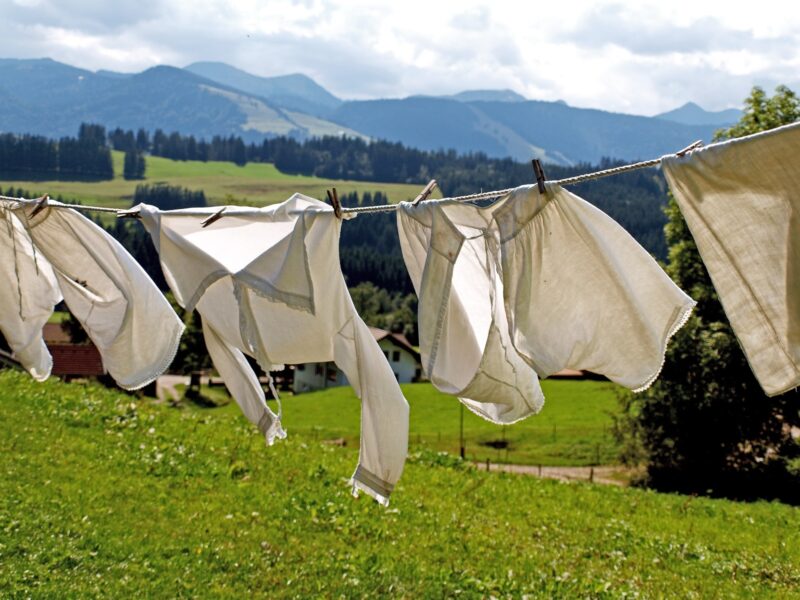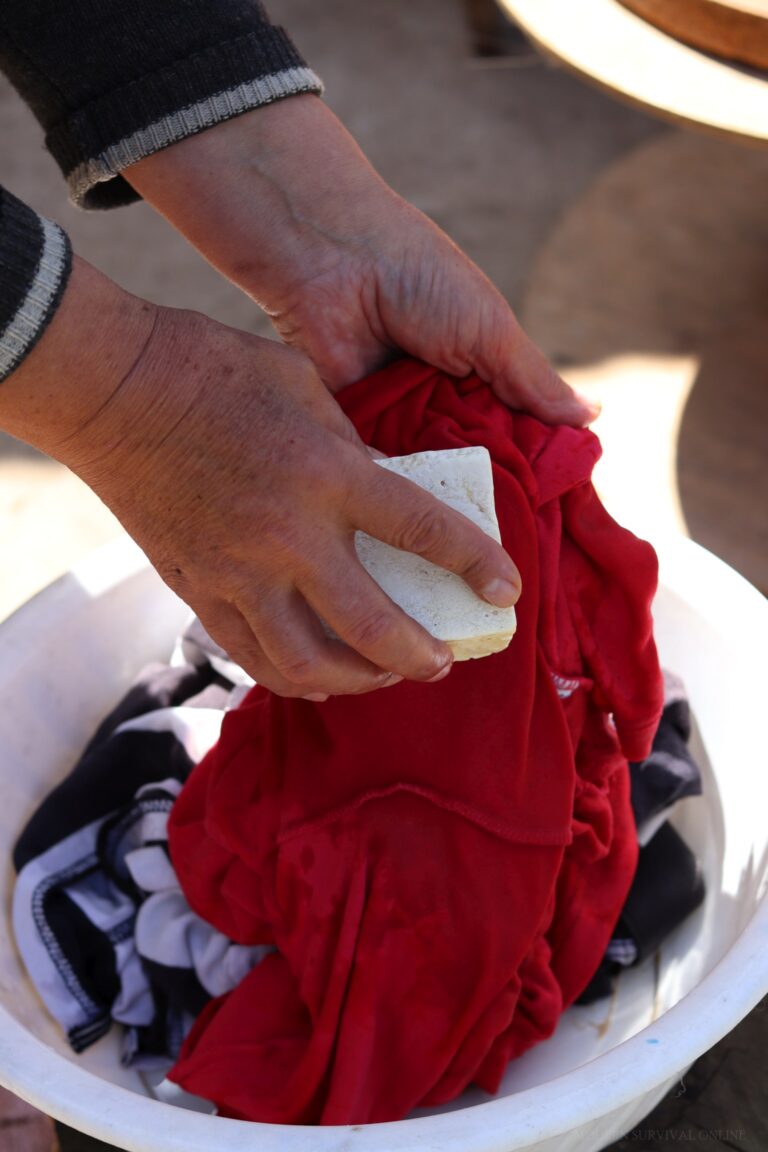When it comes to an extended power outage, whether living off grid by choice or due to a SHTF situation, one of the things just about everyone will have to figure out eventually is how to do laundry.

Your standard electric powered washer and dryer set most likely won’t be functioning unless you’ve planned ahead for the strain on your solar powered system or generator.
If we look back in history though, we know that although many may not remember it, there was a time when powered washers and dryers didn’t even exist.
Most of the ways to do laundry post-SHTF we’ve included on our list involve those methods used by our early ancestors along with some recent inventions that have since been designed to conserve water and reduce reliance on power.
Non-Electric Methods Used by Our Ancestors to Do Landry
Our ancestors had to make do without electric washers and dryers. So for those of us who are looking for ways to do laundry post-SHTF, some of those early methods could be an option.
1. Beat Over Rocks or Stone
Our really early ancestors washed their clothes using the closest river or stream. They would beat and scrub or even trample the clothes over rocks or stones near the water’s edge and then rinse and repeat the process.
If you find yourself with easy access to a river or stream post-SHTF, this method could help you keep your clothes clean.
2. Cast Iron Cauldron
As the population grew and towns expanded, a river or stream wasn’t always nearby. Large vats or cauldrons would be filled with water and heated, the clothes thrown in, and then agitated using large wooden implements, called dollie sticks, or even by trampling them using their feet.
“Soap” wasn’t even a thing until the 19th century so believe it or not, human urine, referred to as chamber lye, was actually used to remove grease, stains, and help whiten clothes.

3. Hand wash in bathtub or sink
Many people still wash their clothes in their bathtub or sink. In most cases, you’ll want to use a washboard, a plunger, or a dollie stick to help agitate the clothes and get them clean.
4. Washboard and Bucket
Using a washboard and bucket became the new norm during the industrial revolution period. Some people used washboards in a stream or river, others used them in tubs of water. The invention of the automatic powered washing machine almost rendered the washboard obsolete.
But in recent decades, more and more people are looking for no tech and environmentally safer methods for doing things. Washboards come in several sizes and can be used just about anywhere you need to wash clothes. For more information, watch this video on why you need a washboard.
5. Hand Cranked Agitator-Type Wash Tub
If you can get your hands on one from an older relative or perhaps a flea market or antique store, consider one of the early hand-cranked agitator wash tubs like seen in the video below:
3. Gasoline-Powered Maytag Wringer Washer
Some people may want to consider something like the gasoline powered wringer washer. It is very loud when operating so it won’t be a good idea if you are in a situation where attracting attention to your location might make you a target.
But if you simply want something you can use to wash clothes without relying on electrical power, this would work. You can see an example of one in the video below:
More Recent Portable Methods
As more people seek out ways to do laundry while on the go whether for traveling, hiking, camping, or even bugging out, manufacturers have come up with portable methods for doing laundry. Many of these portable methods will also work post-SHTF when power is down or access to power is limited.
Breathing Mobile Washer
This is a great portable method for washing clothes. It works great for short term power outages, for quick loads between laundry days, and as an off grid laundry method.
WonderWash hand cranked portable washer
This newly invented portable clothes washer is hand cranked. It’s small and takes up very little space. You can even use it right on your kitchen counter. The video below shows you how to use the WonderWash and includes an example of the amount of clothes you can wash at one time.
Scrubba Tactical Wash Bag
This phenomenal little bag is great for washing clothes on the go. It’s made of sturdy, waterproof nylon and rolls down and clips to close.
This means your scrubba tactical wash bag can not only be used to wash your clothes, it can also double as a dry bag for your supplies or gear in a pinch.
It’s lightweight and compresses easily to take up very little space in your BOB when not in use. The inside of the Scrubba Wash Bag is designed with a flexible internal washboard which gently scrubs your clothes as you rub the outside of the bag.
The tactical wash bag is more discreet and comes in a neutral color that won’t attract attention.For more details, watch this how to use Scrubba Wash Bag video review:
Washing Wand
The washing wand works in a similar way to the breathing mobile washer. It does have a durable plastic handle rather than a wooden one.
You’ll need to buy a bucket or some other type of wash tub or tote separately. For a visual of how this works watch this washing wand how to video:
Alternative Methods and DIY
In addition to the methods designed for washing clothes, many people have found alternative and DIY ways to wash clothes that may be an option post-SHTF. We’ve listed several of these ideas below for your consideration.
Mop Bucket and Wringer
If you’re looking for an alternative way to do laundry post-SHTF, it is possible to do small loads using a mop bucket and wringer. Buy one new or find one used on Craigslist or at a flea market.
Be sure to clean it thoroughly if you buy one used to remove any residue that may be leftover. Fill the bucket halfway with water, drop your clothes into it and use a washing wand or the breathing mobile washer to agitate the clothes. Use the wringer to remove excess water and hang dry.
Spin Mop Bucket
Many people have had good luck using a spin mop bucket to do laundry. You’ll need a washing wand or dollie stick to help agitate clothes but you can then remove excess water by placing clothes in the spin section of the bucket. Most spin sections operate with a foot pedal or hand crank. Hang to dry.
DIY With a Concrete Mixer
If you are really creative and you do have access to enough power, you can even use a portable concrete mixer to wash your clothes post-SHTF like in the video below:
Portable Electric Spin Dryers
If you do have access to electricity either through solar power or a generator, you can add one of these handy electric spin dryers to your post-SHTF laundry equipment.
Spin dryers can drastically reduce the amount of time it takes for your clothes to finish drying once they are hung up. Users claim the spin dryers remove enough excess water to allow clothes to dry on the line within an hour or less.
Portable Compact Washer with Spin Dryer
For those who may not have the space for a full size washer and dryer set or if you are doing laundry post-SHTF with just your standard power via a generator or solar power system, consider something like this portable compact combination washer and spin dryer.
The Laundry Alternative Ninja Spin Dryer or Panda Portable Dryer are both popular options for removing excess water from clothing. The more water you can pull from your clothes with a spin dryer, the less time they will take to dry.
Many people use these on a daily basis. These methods do require power so you’ll need to have some access to use them.
Drying Racks
Once you’ve washed your clothes and wrung or spun them to remove excess water, you need a way to finish drying your clothes. Most people will use a combination of methods for drying clothes depending on the season or climate where they live.
The traditional clothesline or outdoor drying rack is a tried and true method. You may need to consider a drip dry bar in your shower or laundry room or an indoor drying rack in colder months. The length of time needed to dry freshly washed clothes is drastically reduced when you use one of the spin dryers above.
So…
Do you have a current plan for a way to do laundry post-SHTF? Are you already using an alternative method for washing and drying clothes that works well for your family? Share your experience in the comments.


Like what you read?
Then you're gonna love my free PDF, 20 common survival items, 20 uncommon survival uses for each. That's 400 total uses for these dirt-cheap little items!
We will not spam you.
We have a Lavario. It sits in the bath tub or shower and has spigot type drain. I suppose you could use it outside in good weather.The larger capacity is a real plus,and you can operate it with “kid power”. I have a wash board and one of the small spinning tubs which were picked up really cheap at the second hand store,but the Lavario works so much better.The Lavario is a little pricey and may not fit your budget,but working smart, not hard, if the power is out will be a good thing,It is said that in a SHTF event certain skills will be valuable.Maybe like doing a load of laundry in exchange for a can of soup or beans.The Lord willing we may never need any of this.
GOD BLESS and Long Live The Republic!!!